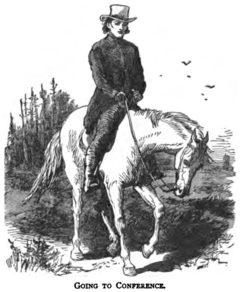Methodism, also called the Methodist movement, is a Protestant Christian tradition whose origins, doctrine and practice derive from the life and teachings of John Wesley. George Whitefield and John's brother Charles Wesley were also significant early leaders in the movement. They were named Methodists for "the methodical way in which they carried out their Christian faith". Methodism originated as a revival movement within Anglicanism originating out of the Church of England in the 18th century and became a separate denomination after Wesley's death. The movement spread throughout the British Empire, the United States and beyond because of vigorous missionary work, and today has about 80 million adherents worldwide.

The United Methodist Church (UMC) is a worldwide mainline Protestant denomination based in the United States, and a major part of Methodism. In the 19th century, its main predecessor, the Methodist Episcopal Church, was a leader in evangelicalism. The present denomination was founded in 1968 in Dallas, Texas, by union of the Methodist Church and the Evangelical United Brethren Church. The UMC traces its roots back to the revival movement of John and Charles Wesley in England, as well as the Great Awakening in the United States. As such, the church's theological orientation is decidedly Wesleyan. It embraces liturgical worship, holiness, and evangelical elements.

The Second Great Awakening was a Protestant religious revival during the late 18th to early 19th century in the United States. It spread religion through revivals and emotional preaching and sparked a number of reform movements. Revivals were a key part of the movement and attracted hundreds of converts to new Protestant denominations. The Methodist Church used circuit riders to reach people in frontier locations.

Francis Asbury was a British-American Methodist minister who became one of the first two bishops of the Methodist Episcopal Church in the United States. During his 45 years in the colonies and the newly independent United States, he devoted his life to ministry, traveling on horseback and by carriage thousands of miles to those living on the frontier.
The Methodist Episcopal Church (MEC) was the oldest and largest Methodist denomination in the United States from its founding in 1784 until 1939. It was also the first religious denomination in the US to organize itself nationally. In 1939, the MEC reunited with two breakaway Methodist denominations to form the Methodist Church. In 1968, the Methodist Church merged with the Evangelical United Brethren Church to form the United Methodist Church.
A Methodist local preacher is a layperson who has been accredited by the Methodist Church to lead worship and preach on a frequent basis. With separation from the Church of England by the end of the 18th century, a clear distinction was recognised between itinerant preachers and the local preachers who assisted them. Local preachers have played an important role in Methodism since the earliest days of the movement, and have also been important in English social history. These preachers continue to serve an indispensable role in the Methodist Church of Great Britain, in which the majority of church services are led by laypeople. In certain Methodist connexions, a person becomes a local preacher after obtaining a license to preach. In many parts of Methodism, such as the Allegheny Wesleyan Methodist Connection, there are thus two different tiers of ministers—licensed preachers and ordained elders.
Connexionalism, also spelled connectionalism, is the theological understanding and foundation of Methodist ecclesiastical polity, as practised in the Methodist Church in Britain, Ireland, Caribbean and the Americas, United Methodist Church, Free Methodist Church, African Methodist Episcopal and Episcopal Zion churches, Bible Methodist Connection of Churches, Christian Methodist Episcopal Church, and many of the countries where Methodism was established by missionaries sent out from these churches. It refers to the way in which Methodist churches and other institutions are connected and work together to support one another, share resources, and carry out mission and ministry. The United Methodist Church defines connection as the principle that "all leaders and congregations are connected in a network of loyalties and commitments that support, yet supersede, local concerns." Accordingly, the primary decision-making bodies in Methodism are conferences, which serve to gather together representatives of various levels of church hierarchy.
A circuit preacher is a Christian minister who, in response to a shortage of ministers, officiates at multiple churches in an area, thus covering a "circuit".
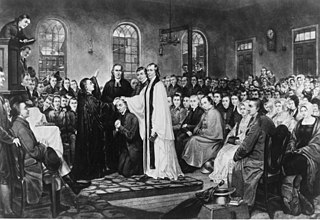
The Christmas Conference was an historic founding conference of the newly independent Methodists within the United States held just after the American Revolution at Lovely Lane Chapel in Baltimore, Maryland, in 1784.
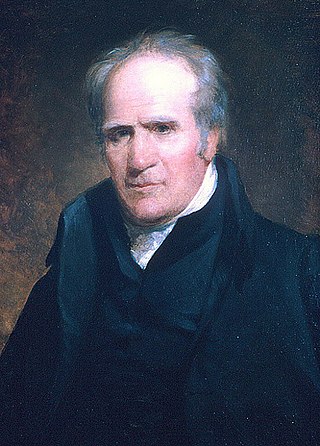
Robert Richford Roberts distinguished himself as an American Methodist circuit rider, pastor, presiding elder, and bishop of the Methodist Episcopal Church, elected in 1816. He was the first married man in America to serve as bishop of the Methodist Episcopal Church.
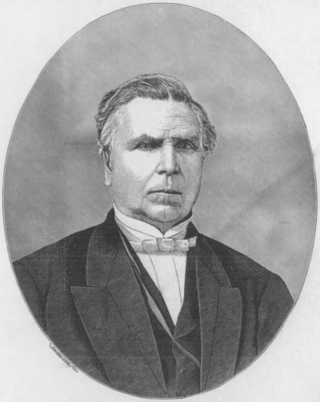
Edward Raymond Ames was an American Bishop of the Methodist Episcopal Church, elected in 1852.
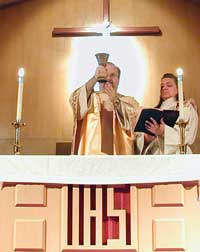
An elder, in many Methodist churches, is an ordained minister that has the responsibilities to preach and teach, preside at the celebration of the sacraments, administer the church through pastoral guidance, and lead the congregations under their care in service ministry to the world.

St. George's United Methodist Church, located at the corner of 4th and New Streets, in the Old City neighborhood of Philadelphia, is the oldest Methodist church in continuous use in the United States, beginning in 1769. The congregation was founded in 1767, meeting initially in a sail loft on Dock Street, and in 1769 it purchased the shell of a building which had been erected in 1763 by a German Reformed congregation. At this time, Methodists had not yet broken away from the Anglican Church and the Methodist Episcopal Church was not founded until 1784.

James O'Kelly was an American clergyman during the Second Great Awakening and an important figure in the early history of Methodism in America. He was also known for his outspoken views on abolitionism, penning the strong antislavery work, Essay on Negro Slavery.
John B. Matthias is known as the writer of the words and music for the gospel song, “Palms of Victory”, for which he is generally given credit. He was typical of Methodist Episcopal circuit riders in early 19th Century United States.
Methodist views on the ordination of women in the rite of holy orders are diverse.

The history of Methodism in the United States dates back to the mid-18th century with the ministries of early Methodist preachers such as Laurence Coughlan and Robert Strawbridge. Following the American Revolution most of the Anglican clergy who had been in America came back to England. John Wesley, the founder of Methodism, sent Thomas Coke to America where he and Francis Asbury founded the Methodist Episcopal Church, which was to later establish itself as the largest denomination in America during the 19th century.

Harry Hosier, better known during his life as "Black Harry", was an African American Methodist preacher during the Second Great Awakening in the early United States. Dr. Benjamin Rush said that, "making allowances for his illiteracy, he was the greatest orator in America". His style was widely influential but he was never formally ordained by the Methodist Episcopal Church or the Rev. Richard Allen's separate African Methodist Episcopal Church in Philadelphia.
The Bible Methodist Connection of Churches is a Methodist denomination within the conservative holiness movement.
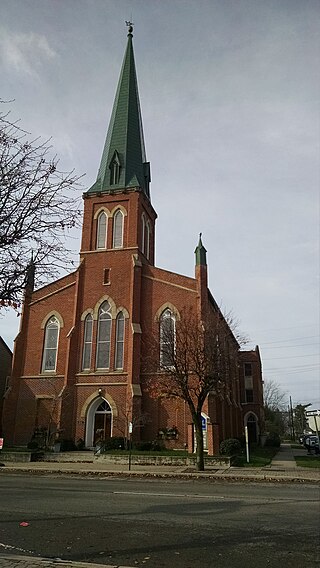
The Franklin First United Methodist Church is a historic church in downtown Franklin, Ohio, USA. A Methodist affiliated church since its founding, it is the oldest church in the city and one of the oldest churches in Warren County. The church is a member congregation of the United Methodist Church.
